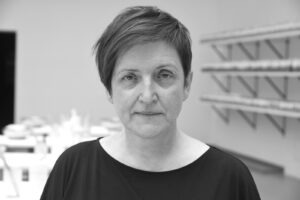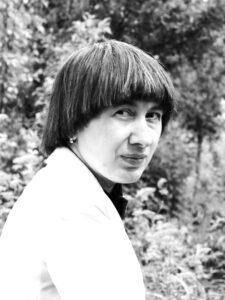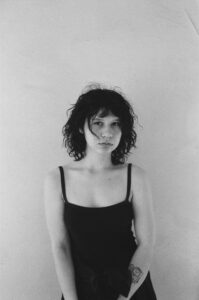Ewa Hubar

– born in 1982 in Białystok – a choreographer, anthropologist and masseuse. She works with corporeality, the political and cultural aspects of the body, the anthropology of embodiment as well as dreaming and imagination. She instigates actions based on a non-hierarchical exchange of knowledge and, above all, embodied experience. It is in experience and participation itself that she sees the poetic, feminist potential of producing and receiving art. She holds a degree from the Nicolaus Copernicus University in Toruń: Cultural Anthropology and International Relations, as well as art schools in Denmark in the field of dance theatre: Akademi for Musik, Dans & Teater in Copenhagen and Musik og Teater Højskolen in Toftlund. Two-time grantee of the Grazyna Kulczyk Art Stations Foundation as part of the Alternative Dance Academy (Stary Browar Nowy Taniec) in Poznań in 2014 and 2017.
My artistic practice, as well as my view of myself as an artist, is one of constant formation, experimentation and questioning. My experience derives from working with the body, dance and choreography, in particular so-called experimental choreography, which often abandons the constructional form of dance and is more concerned with exploring movement in time and space, reaching out to other fields of art and science and focusing on the search for its own traces, meanings and imagery.
I have studied not only dance and choreography, but also Cultural Anthropology, and I increasingly realise that my understanding of art, the process of making art and my anthropological knowledge are very closely related, merging in many aspects and giving me a variety of artistic and investigative tools. I have never been interested in performance itself, in representing something on stage in front of an audience, despite the many years I have been studying it and progressing in this direction. What I am most interested in in the creative process is sharing and allowing access to the experience of art. It is in the embodied experience and participation itself that I see the poetic potential of producing art. This is why I find myself so at home at events such as the Post-Artistic Congress in Sokołowsko (2021), where I shared my practice related to imagination, dreams, the body and perception, which are also part of the trend of what is known as sensory ethnography. The intervention, entitled Poetics of Perception. Perceptual Dreaming12, took the form of a workshop in which we closed our eyes and explored the subtle form of working with touch. We treated and recorded the experience as a dream and then worked with the text generated.
I am interested in making ‘art beyond art’3, crossing disciplinary boundaries, egalitarianism and shifting meanings, the things I do to experience, to share, to experiment, to be everyday, more to imagine than to represent. This is the understanding of art I have derived from somatic and choreographic practices. I replace the materiality of art with experience and imaginative play, action, creator-recipient relationships. Artistic tools serve as a vehicle for me to experience. My first experiments in this direction started during a research laboratory I co-organised and co-led in 2011, in Krakow, Poland, titled Anthropology of Embodiment. Theory and Practice4. The lab was addressed to students of the humanities. Using interdisciplinary tools, we searched for connections between theoretical and practical knowledge in the fields of anthropology and performing arts. Here, the body and its various contexts played the key role. We would read scientific texts, we would move, we would listen to the body more than we would create new theories. It was my first important experience of what I would now call artistic research.
Jerzy Ludwiński’s metaphor, comparing the development of contemporary art to a rolling snowball that keeps growing, absorbing successive elements of reality to finally become a globe, fits well with my activities5. I started my path with somatic dance, choreographic practices and body work (I still practice traditional Thai massage), joined by theoretical anthropological work and performative actions, and later dream work. More recently, I’ve been inspired by writing as a performative practice – I’ve written a number of performative texts, including How to start a revolution in Australia, Choreography of failures, Make America a pussy again, P for programme6 – and working in the radio field (I’m producing an original show on community radio station Kapitał, called Dream Time)7. Only instead of a snowball, I will probably make a snowman.
The collection of all my tools and experiences brings me to focus on touching and creating different kinds of closeness, intimacy and vulnerability, but also community. I find the social aspect of experiencing art extremely important, as well as exploring and bringing out different social and cultural practices (not only from the European cultural circle) that cultivate qualities that are nowadays forgotten, downplayed or even ignored in the capitalist socio-economic system. One such neglected practice for me is dream-telling and dream-sharing, a quality that is present and still alive in many traditional South American cultures. Another practice that inspires me is dadirri – deep listening, quiet awareness and waiting, practised by an aboriginal ethnic group in Australia. My aim is not to directly transfer these practices to my cultural context, but rather to draw attention to aspects of the social aspects of Western culture that are repressed or unnoticed. And it is in art and artistic practices that I see the potential to reclaim them.
The body, dreams, subtle forms of experience, attentiveness to perceive and move, culturally different ways of knowing are all areas of experience and poetics. The etymology of the word poetry comes from the Greek poiesis, which means to create and to act, so it is in action and experience that I see art being created, which gives me some kind of respite from the oppressiveness of Western culture, norms and social relations dictated by the capitalist system. Using marginalised practices of presence and action in the world (such as dance, or dream-telling) is deeply feminist for me. It represents my personal form of resistance and rebellion against patriarchal norms.
Another important aspect of the creative and educational process for me is the building of horizontal relationships. I developed this while still pursuing my education in Denmark. There I studied dance theatre and contemporary dance first at one of the artistic højskole and later at the Københavns Akademi for Musik, Dans & Teater. A højskole is a so-called ‘people’s school’, where the educational process is based on community co-creation, nurturing work spaces and community action. I adopted there, maybe not completely non-hierarchical, but certainly more equal, a culture of learning, being with each other and co-creating, as well as educational and artistic practices. With this experience in mind, it is still difficult for me to find my way in Poland, where, to my mind, social relations are still strongly based on a system of power and control. For a few years of living in Bialystok (my home town), I tried to share this experience by leading movement classes, mostly addressed to women. Sometimes we turned the classes into performative actions, such as having a meal together at a table we brought, in one of the squares in the city centre (Kiosk Ruchu, 2011-2015)8.
Lately I’ve been thinking a lot about the time just before falling asleep, when we sing lullabies or when our conscious, controlling mind starts to let go. I have read somewhere that this is the moment when we are most human.
The text was written in collaboration with Bogna Stefańska (2022).
1Image: Ewa Hubar, Poetics of Perception. Perceptual Dreaming, Contexts. Postartistic Congress 2021, see: konteksty.to/ewa-hubar/. Courtesy of the artist.2Image: Ewa Hubar, Poetics of Perception. Perceptual Dreaming, Contexts.Postartistic Congress 2021, see: konteksty.to/ewa-hubar/. Courtesy of the artist.
3Rasheed Araeen, Art Beyond Art: Ecoaesthetics. A Manifesto for the 21st Century, Third Text 2010.
4Image: Ewa Hubar, Anthropology of Embodiment. Theory and Practice, 2011. Project carried out in cooperation with the Jagiellonian University, the Ethnographic Museum in Cracow and the University of Ljubljana. Courtesy of the artist.
5Jerzy Ludwiński, Art in the Postartistic Times, 1972, Fine Arts Academy in Poznan, 2009.
6Ewa Hubar, Writing as a Performance Practice, see: wappeh.wixsite.com/wapp.
7Ewa Hubar, radio show Dream Time, Radio Capital, see: radiokapital.pl/shows/pasmo-goscinne/ewa-hubar-i-jej-gosc-daniel-godinez-nivon/.
8Image: Ewa Hubar, Kiosk ruchu, 2014. Courtesy of the artist.
– urodzona w 1982 roku w Białymstoku – choreografka, antropolożka i masażystka. Zajmuje się cielesnością, polityczno-kulturowymi aspektami ciała, antropologią ucieleśnienia oraz śnieniem i wyobraźnią. Inicjuje działania oparte na niehierarchicznej wymianie wiedzy, a przede wszystkim ucieleśnionym doświadczeniu. To właśnie w samym doświadczeniu i partycypacji widzi poetycki, feministyczny potencjał wytwarzania i odbierania sztuki. Ukończyła Uniwersytet Mikołaja Kopernika w Toruniu: Antropologię Kultury i Stosunki Międzynarodowe oraz szkoły artystyczne w Danii w zakresie teatru tańca: Akademi for Musik, Dans & Teater w Kopenhadze oraz Musik og Teater Højskolen w Toftlund. Dwukrotna stypendystka Art Stations Foundation Grażyny Kulczyk w ramach Alternatywnej Akademii Tańca (Stary Browar Nowy Taniec) w Poznaniu w latach 2014 i 2017.
Moja praca artystyczna, ale też myślenie o sobie samej jako o artystce, ma charakter ciągłego formowania się, eksperymentowania i poddawania pytaniom. Moja praktyka wywodzi się z pracy z ciałem, tańcem i choreografią, w szczególności tak zwaną choreografią eksperymentalną, w której często rezygnuje się z formy konstruowania tańca, a bardziej poddaje się badaniu ruch w czasie i przestrzeni, sięga do innych dziedzin sztuki i nauki oraz skupia na poszukiwaniu swoich własnych śladów, znaczeń i wyobrażeń.
Studiowałam nie tylko taniec i choreografię, ale też Antropologię Kultury i coraz częściej uświadamiam sobie, że moje rozumienie sztuki, proces jej tworzenia i moja wiedza antropologiczna są bardzo blisko siebie, łączą się w wielu aspektach i dają mi różnorodne narzędzia artystyczne i badawcze. Nigdy nie interesowało mnie samo performowanie, reprezentowanie czegoś na scenie przed publicznością, pomimo wielu lat uczenia się i rozwijania w tym kierunku. W procesie twórczym najbardziej zależy mi na dzieleniu się i umożliwianiu dostępu do doświadczania sztuki. To właśnie w samym ucieleśnionym doświadczeniu i partycypacji widzę poetycki potencjał wytwarzania sztuki. Dlatego tak dobrze odnajduję się w takich przedsięwzięciach jak Kongres Postartystyczny w Sokołowsku (2021), gdzie podzieliłam się swoją praktyką związaną z wyobraźnią, snami, ciałem i percepcją, wpisującymi się także w nurt, tak zwanej, etnografii sensorycznej. Działanie zatytułowane Poetyka percepcji. Percepcja śnienia12 miało ono formę warsztatu, podczas którego zamykaliśmy oczy i eksplorowaliśmy subtelną formę pracy z dotykiem. Doświadczenie te traktowaliśmy i zapisywaliśmy jako sen, a później pracowaliśmy ze stworzonym tekstem.
Interesuje mnie uprawianie „sztuki poza sztuką”3, przekraczanie granic dyscyplin, egalitaryzm i przesuwanie znaczenia, tego, co robię w stronę doświadczania, współdzielenia, eksperymentowania, codzienności, bardziej wyobrażania sobie niż reprezentowania. Takie rozumienie sztuki wyniosłam z praktyk somatycznych i choreograficznych. Materialność sztuki zastępuję doświadczeniem i grą wyobraźni, działaniem, relacjami twórców-odbiorców. Narzędzia artystyczne są dla mnie wehikułem do doświadczania. Moje pierwsze eksperymenty w tym kierunku zaczęłam podczas współorganizowanego i współprowadzonego przeze mnie w 2011 roku, w Krakowie, laboratorium badawczego Antropologia ucieleśnienia. Teoria i praktyka4. Było to laboratorium skierowane do studentów nauk humanistycznych. Korzystając z interdyscyplinarnych narzędzi poszukiwaliśmy powiązań między wiedzą teoretyczną i praktyczną w obszarze antropologii i sztuk performatywnych. Ciało i różne jego konteksty odgrywały kluczową rolę. Czytaliśmy teksty naukowe, ruszaliśmy się, bardziej słuchaliśmy ciała niż tworzyliśmy nowe teorie. Było to moje pierwsze ważne doświadczenie, które teraz nazwałabym badaniami artystycznymi.
Do moich działań dobrze pasuje metafora Jerzego Ludwińskiego, porównującego rozwój sztuki współczesnej do toczącej się kuli śniegowej, która stale rośnie, wchłaniając kolejne elementy rzeczywistości, aby wreszcie stać się kulą ziemską5. Swoją drogę zaczęłam od somatycznych praktyk tanecznych, choreograficznych i pracy z ciałem (nadal praktykuję tradycyjny masaż tajski), dołączyłam do tego teoretyczną pracę antropologiczną i działania performatywne, a później pracę ze snami. Ostatnio inspiruje mnie pisanie jako praktyka performatywna – napisałam kilka tekstów performatywnych, między innymi How to start a revolution in Australia, Choreography of failures, Make America a pussy again, P jak program6 – i praca w obszarze radiowym (realizuję autorską audycję w społecznościowym Radiu Kapitał, zatytułowaną Czas Snu7). Tylko ja zamiast kuli śnieżnej ulepię zapewne bałwana.
Zbiór moich wszystkich narzędzi i doświadczeń prowadzi mnie do skupienia na dotykaniu i tworzeniu różnego rodzaju bliskości, intymności i wrażliwości, ale też wspólnotowości. Niezwykle istotny jest dla mnie społeczny aspekt doświadczania sztuki oraz eksplorowanie i wydobywanie różnych praktyk społecznych i kulturowych (pochodzących nie tylko z europejskiego kręgu kulturowego), które kultywują te jakości, o których współcześnie zapominamy, umniejszamy ich wartość, a nawet ignorujemy w kapitalistycznym systemie społeczno-ekonomicznym. Jedną z takich zapomnianych praktyk jest dla mnie opowiadanie snów i dzielenie się nimi, które to praktyki są obecne i wciąż żywe w wielu kulturach tradycyjnych Ameryki Południowej. Inną inspirującą mnie praktyką jest dadirri – głębokie słuchanie, spokojna świadomość i czekanie, praktykowane przez jedną z grup etnicznych aborygenów w Australii. Nie chodzi mi o bezpośrednie przenoszenie tych praktyk w mój kontekst kulturowy, a raczej zwrócenie uwagi na takie aspekty społeczne kultury zachodniej, które są wypierane lub niezauważane. I to właśnie w sztuce i praktykach artystycznych widzę potencjał do ich odzyskiwania.
Ciało, sny, subtelne formy doświadczania, uważność percypowania i ruchu, kulturowo różne sposoby poznania (ang. ways of knowing) to obszary doświadczenia i poetyki. Etymologia słowa poezja pochodzi z greckiego poiesis, co oznacza tworzenie i działanie, dlatego właśnie w działaniu i doświadczaniu widzę tworzącą się sztukę, która daje mi jakiś rodzaj wytchnienia od opresyjności zachodniej kultury, norm i relacji społecznych dyktowanych przez kapitalistyczny system. Posługiwanie się marginalizowanymi praktykami obecności i działania w świecie (jak chociażby taniec, czy opowiadanie snów) jest dla mnie głęboko feministyczne. Stanowi to moją osobistą formę oporu i buntu wobec patriarchalnych norm.
Innym istotnym aspektem procesu twórczego i edukacyjnego jest dla mnie budowanie horyzontalnych relacji. Ukształtowało się to we mnie jeszcze podczas edukacji w Danii. Studiowałam tam teatr tańca i taniec współczesny najpierw w jednym z artystycznych højskole, a później w Københavns Akademi for Musik, Dans & Teater. Højskole to tak zwana „szkoła ludowa”, gdzie proces edukacyjny opiera się na współtworzeniu społeczności, dbaniu o przestrzeń pracy i wspólnotowe działania. Zaadoptowałam tam, może nie całkowicie niehierarchiczną, ale z pewnością bardziej równościową, kulturę uczenia się, bycia ze sobą i współtworzenia, praktyk edukacyjnych i artystycznych. W kontekście tego doświadczenia jest mi wciąż trudno odnaleźć się w Polsce, gdzie, z mojej perspektywy, relacje społeczne nadal mocno opierają się na systemie władzy i kontroli. Przez kilka lat mieszkania w Białymstoku (moim rodzinnym mieście) starałam się dzielić tym doświadczeniem prowadząc zajęcia ruchowe, skierowane głównie do kobiet. Czasem zajęcia zmieniałyśmy w akcje performatywne, jak na przykład wspólny posiłek przy przyniesionym przez nas stole, na jednym ze skwerów w centrum miasta (Kiosk Ruchu, 2011-2015)8.
Ostatnio dużo myślę o czasie tuż przed zaśnięciem, kiedy śpiewamy kołysanki albo nasz świadomy, kontrolujący umysł zaczyna odpuszczać. Przeczytałam gdzieś, że to jest właśnie moment, w którym jesteśmy najbardziej ludźmi.
Tekst powstał we współpracy z Bogną Stefańską (2022).
1Zdjęcie: Ewa Hubar, Poetyka percepcji. Percepcja śnienia, Konteksty. Kongres postartystyczny 2021, zob.: konteksty.to/ewa-hubar/. Dzięki uprzejmości artystki.2Zdjęcie: Ewa Hubar, Poetyka percepcji. Percepcja śnienia, Konteksty. Kongres postartystyczny 2021, zob.: konteksty.to/ewa-hubar/. Dzięki uprzejmości artystki.
3Rasheed Araeen, Art Beyond Art: Ecoaesthetics. A Manifesto for the 21st Century, Third Text 2010.
4Zdjęcie: Ewa Hubar, Antropologia ucieleśnienia. Teoria i praktyka, 2011. Projekt zrealizowany we współpracy z Uniwersytetem Jagiellońskim, Muzeum Etnograficznym w Krakowie i Uniwersytetem w Lublanie. Dzięki uprzejmości artystki.
5Jerzy Ludwiński, Sztuka w epoce postartystycznej, 1972, Akademia Sztuk Pięknych w Poznaniu, Poznań 2009.
6Ewa Hubar, Writing as a Performance Practice, zob.: wappeh.wixsite.com/wapp.
7Ewa Hubar, audycja Czas Snu, Radio Kapitał, zob.: radiokapital.pl/shows/pasmo-goscinne/ewa-hubar-i-jej-gosc-daniel-godinez-nivon/.
8Zdjęcie: Ewa Hubar, Kiosk ruchu, 2014. Dzięki uprzejmości artystki.



